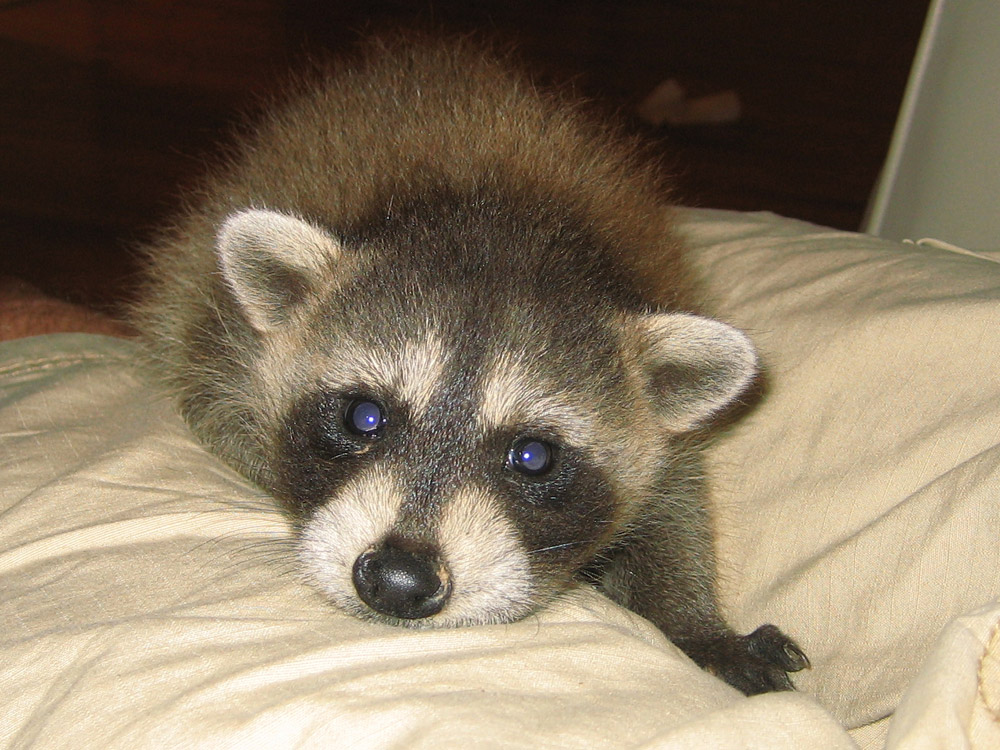
Common raccoon, or North American raccoon, or Northern raccoon(Procyon lotor)
Phylum —chordata
Class — mammalia
Order — carnivora
Family — procyonidae
Genus – procyon
Appearance
The most distinguishable characteristics of the raccoon are its black mask across the eyes and bushy tail with anywhere from four to ten black rings. The forepaws resemble slender human hands and make the raccoon unusually dexterous. Both their forepaws and hindpaws have five toes. Coloration varies with habitat, but tends to range from grey to reddish brown to buff. Raccoons are stocky in build and generally weigh from six to seven kilograms. Weight varies with habitat and region, though, and can range from 1.8 to 10.4kg. Raccoons are capable of achieving body masses made up of 50% body fat, but it is mostly raccoons in the northern parts of the range that become this fat. Males are usually heavier than females by 10 to 30%. Body length ranges from 603 to 950 mm. Their tails comprise about 42% to 52% of their length, from 192 to 405 mm.
Habitat
The raccoon is a native of North America and lives throughout the United States, as well as parts of Mexico, Canada, and the north of South America. In the 20th century it was introduced elsewhere in the world and now is common in Russia, Germany and Japan.
Behavior
The raccoon is mostly nocturnal, and it is solitary, except for mothers with their young. In winter the raccoon tends to stay sleeping in its den for several weeks. It does not hibernate. They prefer to build their dens in trees, but will also use woodchuck burrows, mines, caves, deserted buildings, garages, barns, rain sewers, or houses. Raccoons make a range of noises including hisses, screams, whistles, growls and snarls. They are strong swimmers, although somewhat reluctant ones, because swimming makes them heavier, as their fur is not waterproof. Raccoons don't travel further than necessary, only as far as they need to in order to find food.
Diet
The raccoon is an omnivore and what it eats depends greatly on its environment. It will commonly eat fruits, plants, nuts, berries, rodents, frogs, eggs, insects and crayfish. In an urban setting it will sift through garbage for food. Most of its diet is invertebrates and plants.
Reproduction
During mating season, males often extent their territory, presumably to encompass the home ranges of potential mates. Raccoons are polygynous and after mating males and females do not continue the association. The breeding seasons runs from February to June. Northern populations usually breed earlier than those in the south. Following a gestation period of about 2 months, the female gives birth to 4-5 kits or cubs. From about 20 weeks old the kits forage with their mother during the night and remain living in her den. Weaning occurs at about 70 days.
Raccoons may live up to 16 years in the wild, but most don't make it past their second year. If they survive their youth, raccoons may live an average of 5 years in the wild.
In captivity
Some people who keep raccoons house them in a large dog crate when they aren't home to watch their pet. However, raccoons are too active to be content in a cage for several hours. So the majority of a pet raccoon's time should be spent roaming your house, playing, climbing on things, exploring, and being mischievous. That means your home must be raccoon-proofed. Raccoons are prone to chewing on cords, climbing on shelves, and knocking down valuables. So anything that might injure them or become damaged must be removed from their area.
If you have the space, it's ideal to provide a secure outdoor enclosure for your raccoon. This is a great option when you're busy or need to leave your home and want your pet to have a safe space to play. An outdoor pen should be as large as possible with walls and a ceiling that will contain your animal. Many people build their own pen from wood and screening. Inside, your raccoon should have access to food, water, shelter, and structures (e.g., large branches) for climbing and jumping. Include toys, such as balls and food puzzles, to keep your pet entertained.
Raccoons are omnivores, meaning they eat both meat and plants. Offer your pet a varied diet, including dog food, poultry, fish, eggs, insects, vegetables, and fruits. Treats, such as nuts and other fatty foods, should be offered sparingly to prevent obesity. A dish of clean water should be available at all times. Consult your veterinarian for the quantity and variety that is best for your animal, as this can vary based on age, size, and activity level.
Raccoons are messy eaters. They like to dunk their food in their water dish prior to consuming it. That means you'll need to regularly change their water and feed them in a location where it's easy to clean up. Most adult raccoons need two meals per day in the early morning and late evening, though follow your vet's advice on this. You can simply put their food in a bowl. But it's also ideal to take some of it to put in food puzzles or hide around their enclosure as a form of enrichment.
 Russian
Russian
 English
English























